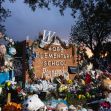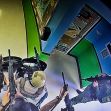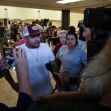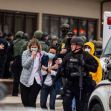Almost a week after the school shooting that rocked the close-knit community of Uvalde, Texas, residents, survivors, and the families of the 19 slain students and two teachers are taking their first steps in what will be a drawn-out and difficult recovery process.
For many, these early stages of the recovery process are laced with more questions than answers over the harrowing event that took place in Robb Elementary School.
Over the weekend, authorities outlined a timeline of the 18-year-old gunman's shooting rampage. The outline details that the shooter, a high school dropout who had just turned 18, was in the school building for 78 minutes. This shocking timeline has left community members and the nation wondering why it took authorities over an hour to stop the shooter.
Before entering the building at 11:33, the gunman walked past classroom windows indiscriminately shooting inside. The shooter was then able to slip inside the building because of a door that had been propped open only six minutes earlier by a teacher in the building.
Once inside the school, the shooter continued his terror as he walked along the hallway banging on classroom doors and looking inside. He eventually took two connected classrooms hostage and would then spend over an hour in them before a border patrol tactical team finally moved in and killed the shooter.
Police Response Criticized
As details over the timeline of events unfolded, community outrage continued to grow over the slow police response. The outline details that a number of students made 911 phone calls alerting authorities that the shooter was in their classroom and that a number of their classmates were dead. Despite these phone calls, authorities took over an hour to finally get into the room and stop the shooter. As the timeline of the events became public, so did footage showing the police responding to concerned parents who were waiting outside the school.
Footage taken by parents outside of the school building while the shooter was in the school shows a chaotic image of parents pleading with police officers to go into the building and rescue their children. One report from the Associated Press highlights the distress parents felt as they pushed officers to do more.
Following the 1999 shooting at Columbine, law enforcement guidelines have maintained the standard that if an active shooter is in a school building, the shooter must be met with the necessary force to stop the threat. If civilians within a school building are the target of the school shooter, the guideline details that police officers must react quickly so that they become the target as opposed to vulnerable students and staff.
According to policies in place for the Uvalde officers who responded to the shooting, the same standard is held. Recent training given to officers regarding a potential school shooting detail that an “officer’s first priority is to move in and confront the attacker. This may include bypassing the injured and not responding to cries for help from children.” As new information continues to be released regarding the shooting, many parents are asking why this policy was not implemented and why the gunman was able to stay in the classroom for over an hour.
One parent, Alfred Garza, who lost his 10-year-old daughter Amerie Jo in the school shooting, shared with CNN, "It doesn't take a genius to figure out that it just took too long to get in there and, you know, had they gotten there sooner, and someone would have taken immediate action, we might have more of those children here today, including my daughter."
Along with other parents, Garza shares that he felt the officers waited too long to get into the building to stop the threat.
In a press conference days after the shooting, the Texas Department of Public Safety director Steven McCraw made the shocking admission that officers had made the wrong decision in not moving more quickly to confront the shooter.
"From the benefit of hindsight where I'm sitting now, of course, it was not the right decision," McCraw shared through visible emotional distress as he addressed the crowd. "It was the wrong decision. Period."
While he was not mentioned by name, the Uvalde School District police chief, Pedro “Pete” Arredondo, is believed to have made the decision that circumstances were no longer that of an active school shooter but were that of a “barricaded subject situation.” Despite having up to 19 police officers outside of the classroom waiting on orders to take down the gunman, the critical mistake to have law enforcement wait so long to breach the classroom has bubbled confusion and outrage among residents in the community. Many are understandably left wondering if more students could have been saved had law enforcement acted more swiftly.
Gun Control Debate Takes Center Stage
The long-running debate about the nation’s gun laws has been reignited as the lax gun laws in Texas have been under the national microscope following the school shooting. Many parents and residents throughout the community voice their concerns about the shooter's ease of access to the semi-automatic weapons that have forever changed the small-town community.
The Texas shooter legally obtained the guns by buying them just days after his 18th birthday. Under federal law, prospective gun owners have to be 18 to buy a rifle like the AR-15-style gun used in the shooting. In addition to the rifles he purchased, the gunman also purchased several hundred rounds of ammunition.
The shooter was able to purchase the guns without submitting to a background check because a handful of states including Texas do not require background checks for most gun purchases. Only dealers who hold federal firearms licenses are required to perform background checks when selling a firearm in the state. However, private sellers online, vendors at gun shows, and even private citizens who sell a used firearm are not required to conduct background checks before making a sale.
These lax firearm rules throughout the state have helped fuel the debate about gun safety in America. For many of the residents of Uvalde and throughout the nation, the NRA’s decision to move forward with their annual convention in nearby Houston, Texas, further added insult to injury following the deadly mass shooting.
Speaking at the conference, former President Trump acknowledged the devastating events in Uvalde but continue to voice his support for the NRA. He detailed that the guns were not to blame for the school shooting, but rather issues including our nation’s mental health crisis and lax school security were the more pertinent threats.
Trump shared, “We need to drastically change our approach to mental health.” He adds, “All of us must unite, Republican and Democrat, in every state and at every level of government to finally harden our schools and protect our children. What we need now is a top-to-bottom security overhaul at schools all across our country.”
Trump went on to emphasize that school safety should be re-examined as part of a comprehensive plan to fight against mass shootings in our nation. One such suggestion was that school buildings should have only one point of entry along with stronger fencing and metal detectors.
Republican sentiments that school safety and gun restrictions are only loosely connected have been met with fierce criticism, with many pointing to the reality that AR-15-style rifles have been the weapon of choice for school shooters since Columbine. It was the same gun used in the devastating 2012 school shooting at Sandy Hook which claimed the lives of 28 students and teachers, the same gun used in the recent mass shooting at a Buffalo supermarket, and the same gun used in the 2017 Las Vegas concert shooting.
Critics are voicing their concern about how easily accessible this military-grade weapon is, mainly to young men who have long fit the profile of what a school shooter looks like. Critics have argued that weak laws including a lack of background checks, non-existent wait times, and lax red flag laws have helped make this preferred mass murder weapon and other destructive firearms easily accessible to individuals who are intent on inflicting unimaginable carnage in their communities.
Hopes for Gun Reform Reignite After Failed Reform Following Sandy Hook Shooting
Following the devastating 2012 mass shooting at Sandy Hook, lawmakers failed to pass comprehensive gun reform laws that would have limited public access to military-grade weapons like the AR-15-style rifle. While comprehensive gun reform was not achieved, some families of victims who lost their lives in the 2012 school shooting were able to reach a settlement with Remington, the gunmaker behind the weapon used by the 20-year-old shooter.
The landmark $73 million settlement was the first time a gun maker was held substantially liable for its role in a mass shooting. Lawyers for nine families who sued the gun maker were able to successfully defend their argument that Remington was in part responsible for the school shooting because it violated marketing practices by marketing the assault-style rifle to young, impressionable audiences.
The lawsuit is believed to be the largest payout made to victims of gun violence by a gun manufacturer. Despite the financial blow to Remington, little has changed as far as how assault-style rifles are accessible to the public.
Nation Seeks Answers Amid String of Mass Shootings
As the nation begins a new round of gun law debates and the profile of an American school shooter continues to take on a clearer image, the residents of Uvalde remain in their agony and grief over the devastating attack that took hold in their community.
While families of victims and community members move forward with questions about how an eighteen-year-old high school dropout was able to inflict such carnage, many throughout the nation are wondering right alongside them why one of the world's most developed nations has yet to find a cure to what feels should be a seemingly preventable crisis.






